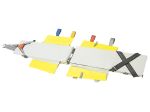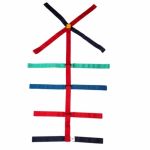
Rescue in Extreme Environments
Rescue operations in extreme environments place exceptional demands on both equipment and skills. Cold, heat, altitude, water and difficult terrain create situations where the margins are small, and personnel must be able to rely entirely on their equipment. At Ferno Norden, we have extensive experience developing solutions that ensure safety even under the most challenging conditions.
Our range includes robust stretchers, transport systems, safety equipment and specialized rescue solutions. All products are thoroughly tested to withstand extreme conditions while providing maximum safety and functionality.
We work closely with emergency services, military forces and volunteer organizations to ensure that our solutions meet real-world needs. Whether in mountains, caves, forests, at sea or in arctic regions, our equipment can be trusted when it matters most.

Forest, Land, and Mountain Rescue
Rescue work in inaccessible environments such as forest, land, and mountain rescue etc. poses different requirements for the equipment. Sometimes the equipment needs to be transported by hand, and injured individuals must be rescued in steep surroundings.
Ferno also manufactures its own products specifically designed for use in rugged terrain environments. This includes everything from wheels for rescue stretchers to using materials like titanium to move equipment over longer distances.
Products for inaccessible environments

Traverse Mule II Rescue Wheel

Traverse PORTER Rescue Wheel

Ferno M71 Rescue Wheel

Wheel kit for Titan 32 - new version

TIROL-KIT Xtreme Control Rescue Wheel

Water Rescue and Maritime Environments
Water rescue and rescue operations in water and inaccessible environments demand high standards for personnel and equipment. Ferno Norden is a global player with products specially designed for rescue operations in water environments, including evacuation equipment, rescue stretchers, and flotation devices, among others.
A rescue mission in a water environment can vary greatly, and the choice of equipment depends on the injury situation.
Products for water rescue

PXB Pool Rescue Spineboard

Evacuation cot Ferno XT Floating

Germa Navy Rescue Mattress II

Traverse Flotation Collar Double Foam Log, Yellow

Najo RediHold backboard m/10

Artic Saana Poncho Hypothermia Heat Blanket

Rescue in Confined Spaces, Shafts, and Pits
In industrial settings, various construction environments, or when working with utilities such as water and sewage, work often takes place in particularly hazardous environments, including confined or tight spaces or at heights. There are clear laws and regulations that require workplace design, ventilation, risk assessments, and equipment, among other things.
Part of this work involves having a plan for rescue and evacuation in the event of acute injuries or illness among personnel. It is important to have a prepared plan and equipment in place to handle the task. The choice of equipment is determined by the conditions in the environment.
Products for rescue in confined spaces

Basket Stretcher Traverse Pinnacle Titanium Divisible

Ferno Paraguard™ Excel NATO Rescue Stretcher

Ferno®XT PRO extrication complete

Rescue Stretcher, Ferno Life Saver

KED® PRO Extrication orange complete.

Ferno XTRIC8 Rescue Stretcher

Rescue Stretcher Traverse Spartan Titanium Divisible

Basket Stretcher Traverse Titanium Tapered Divisible

Basket Stretcher Traverse Advantage

Movement Restriction, Stabilization, and Fixation
Effective patient handling begins with the right equipment for immobilization and transport. Our vacuum splints, vacuum mattresses, and scoop stretchers are designed to ensure safe and stable handling of injured patients, even in the most challenging situations.
Vacuum splints conform to the body for optimal support and stabilization and are easy to use even in rough terrain. Vacuum mattresses provide superior comfort and immobilization and are built to withstand tough conditions and varying temperatures. Scoop stretchers offer precise and secure transfer with a robust and flexible design that adapts to the patient's needs.
With a focus on safety, comfort, and ease of use, our solutions are ideal for professionals who prioritize patient safety.
Products for Movement Restriction, Stabilization, and Fixation

Germa EasyFix PLUS II Vacuum Mattress

Vacuum Splint Set Blue Line Complete Kit R2G

Scoop EXL stretcher, Yellow

X-Spider Multicolor strap

Splint, Ferno Flex Splint, red/grey

Ferno® XT Extrication dev complete

CT-7 Traction Splint EMS

Germa EasyFix Plus Vacuum splint-set R2G

Tripod Quapod Bridge System
Rescue missions often involve lifting a person in distress from wells, cliffs, over quaysides, and similar situations. This type of advanced rescue requires the use of a tripod, quapod, or larger systems such as the Arachnipod Bridge.
All our products in this area are carefully designed for quick adaptation to various rescue missions and are engineered to function effectively in professional rescue operations. See below for our products designed for this purpose.
Tripod Quapod Bridgesystem products

Arachnipod Total Edge system 2M

Tripod EAGLE NEST 3

Arachnipod Standard Bridge 2M

Arachnipod Standard Tripod

Arachnipod Quadpod

Arachnipod Advantage Tripod

Hypothermia
Missions in advanced environments often involve rescuing wet and severely chilled patients who may have a long transport distance. This places high demands on effective hypothermia products. Ferno Norden offers a wide range of products and solutions to address factors such as wind, low temperatures, snow, and precipitation.
Mild hypothermia: The core temperature is 32-35 degrees Celsius. You feel cold with increased heart and respiratory rates. You may experience shivering, increased respiratory rate, increased heart rate, and increased blood pressure. You become apathetic and have trouble making wise decisions. In this situation, passive heating, warm drinks, and nutrition are usually sufficient.
Moderate hypothermia: The core temperature is 28-32 degrees Celsius. Breathing becomes shallow. The heart rate slows down, the cold freezes the body, and the person approaches unconsciousness. The situation is serious, and medical treatment is urgently necessary. In this situation, part of the treatment involves applying external heat.
